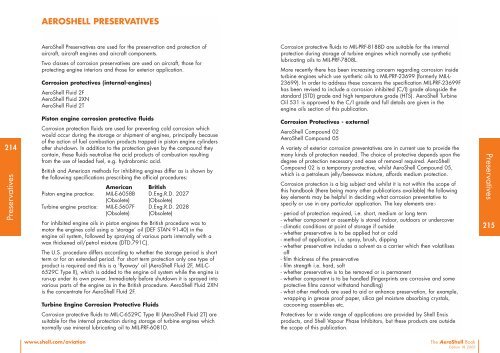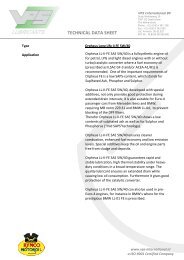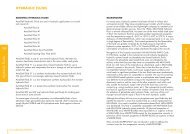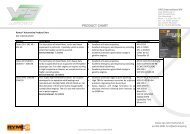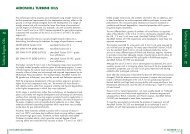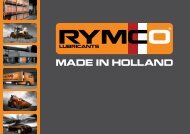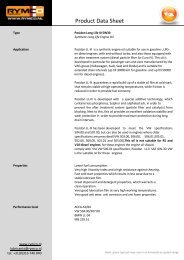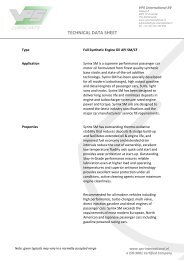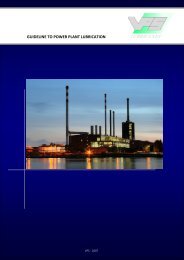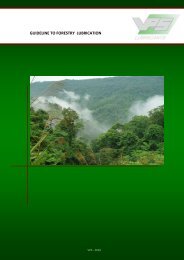Download pdf - VPS Lubricants
Download pdf - VPS Lubricants
Download pdf - VPS Lubricants
You also want an ePaper? Increase the reach of your titles
YUMPU automatically turns print PDFs into web optimized ePapers that Google loves.
AEROSHELL PRESERVATIVES<br />
AeroShell Preservatives are used for the preservation and protection of<br />
aircraft, aircraft engines and aircraft components.<br />
Two classes of corrosion preservatives are used on aircraft, those for<br />
protecting engine interiors and those for exterior application.<br />
Corrosion protectives (internal-engines)<br />
AeroShell Fluid 2F<br />
AeroShell Fluid 2XN<br />
AeroShell Fluid 2T<br />
Corrosion protective fluids to MIL-PRF-8188D are suitable for the internal<br />
protection during storage of turbine engines which normally use synthetic<br />
lubricating oils to MIL-PRF-7808L.<br />
More recently there has been increasing concern regarding corrosion inside<br />
turbine engines which use synthetic oils to MIL-PRF-23699 (formerly MIL-L-<br />
23699). In order to address these concerns the specification MIL-PRF-23699F<br />
has been revised to include a corrosion inhibited (C/I) grade alongside the<br />
standard (STD) grade and high temperature grade (HTS). AeroShell Turbine<br />
Oil 531 is approved to the C/I grade and full details are given in the<br />
engine oils section of this publication.<br />
214<br />
Preservatives<br />
Piston engine corrosion protective fluids<br />
Corrosion protection fluids are used for preventing cold corrosion which<br />
would occur during the storage or shipment of engines, principally because<br />
of the action of fuel combustion products trapped in piston engine cylinders<br />
after shut-down. In addition to the protection given by the compound they<br />
contain, these fluids neutralise the acid products of combustion resulting<br />
from the use of leaded fuel, e.g. hydrobromic acid.<br />
British and American methods for inhibiting engines differ as is shown by<br />
the following specifications prescribing the official procedures:<br />
American British<br />
Piston engine practice: MIL-E-6058B D.Eng.R.D. 2027<br />
(Obsolete) (Obsolete)<br />
Turbine engine practice: MIL-E-5607F D.Eng.R.D. 2028<br />
(Obsolete) (Obsolete)<br />
For inhibited engine oils in piston engines the British procedure was to<br />
motor the engines cold using a ‘storage’ oil (DEF STAN 91-40) in the<br />
engine oil system, followed by spraying of various parts internally with a<br />
wax thickened oil/petrol mixture (DTD.791C).<br />
The U.S. procedure differs according to whether the storage period is short<br />
term or for an extended period. For short term protection only one type of<br />
product is required and this is a ‘flyaway’ oil (AeroShell Fluid 2F, MIL-C-<br />
6529C Type II), which is added to the engine oil system while the engine is<br />
run-up under its own power. Immediately before shutdown it is sprayed into<br />
various parts of the engine as in the British procedure. AeroShell Fluid 2XN<br />
is the concentrate for AeroShell Fluid 2F.<br />
Turbine Engine Corrosion Protective Fluids<br />
Corrosion protective fluids to MIL-C-6529C Type III (AeroShell Fluid 2T) are<br />
suitable for the internal protection during storage of turbine engines which<br />
normally use mineral lubricating oil to MIL-PRF-6081D.<br />
Corrosion Protectives - external<br />
AeroShell Compound 02<br />
AeroShell Compound 05<br />
A variety of exterior corrosion preventatives are in current use to provide the<br />
many kinds of protection needed. The choice of protective depends upon the<br />
degree of protection necessary and ease of removal required. AeroShell<br />
Compound 02 is a temporary protective, whilst AeroShell Compound 05,<br />
which is a petroleum jelly/beeswax mixture, affords medium protection.<br />
Corrosion protection is a big subject and whilst it is not within the scope of<br />
this handbook (there being many other publications available) the following<br />
key elements may be helpful in deciding what corrosion preventative to<br />
specify or use in any particular application. The key elements are:-<br />
- period of protection required, i.e. short, medium or long term<br />
- whether component or assembly is stored indoor, outdoors or undercover<br />
- climatic conditions at point of storage if outside<br />
- whether preservative is to be applied hot or cold<br />
- method of application, i.e. spray, brush, dipping<br />
- whether preservative includes a solvent as a carrier which then volatilises<br />
off<br />
- film thickness of the preservative<br />
- film strength i.e. hard, soft<br />
- whether preservative is to be removed or is permanent<br />
- whether component is to be handled (fingerprints are corrosive and some<br />
protective films cannot withstand handling)<br />
- what other methods are used to aid or enhance preservation, for example,<br />
wrapping in grease proof paper, silica gel moisture absorbing crystals,<br />
cacooning assemblies etc.<br />
Protectives for a wide range of applications are provided by Shell Ensis<br />
products, and Shell Vapour Phase Inhibitors, but these products are outside<br />
the scope of this publication.<br />
Preservatives<br />
215<br />
www.shell.com/aviation<br />
The AeroShell Book<br />
Edition 18 2003
AEROSHELL FLUID 2F<br />
AeroShell Fluid 2F is an inhibited "flyaway" lubricating oil for the internal<br />
protection of piston engines during storage.<br />
PROPERTIES MIL-C-6529C TYPICAL<br />
Type II<br />
216<br />
Preservatives<br />
AeroShell Fluid 2F consists of three parts AeroShell Oil 100 (SAE J-1966<br />
Grade SAE 50) with one part AeroShell Fluid 2XN (MIL-C-6529C Type I) –<br />
a corrosion preventative.<br />
APPLICATIONS<br />
AeroShell Fluid 2F is used as a piston engine preservative oil, also as a<br />
"flyaway" oil, in place of the normal engine oil. A period of 15 minutes<br />
engine running under idling conditions is required to ensure adequate<br />
distribution throughout the engine. It can also be applied to other parts of<br />
the engine and its accessories by spraying. The ashless anti-corrosion<br />
additive package and highly refined mineral base oils protect the engine<br />
by minimising the effects of humidity and neutralising the acidic<br />
components of engine oil oxidation and combustion by-products.<br />
After storage and before operating the engine, rotate the crankshaft by<br />
hand and drain off the preservative oil. An additional optional precaution<br />
is to flush the engine with the correct grade of AeroShell oil before draining<br />
and re-filling with fresh oil.<br />
Operation of engines containing "flyaway" oils is limited to 50 hours<br />
maximum. Detailed instructions for inhibiting piston engines are given in<br />
specifications MIL-E-6058B and MIL-E-6059A and in relevant engine<br />
manufacturer’s publications.<br />
AeroShell Fluid 2F may be used in conjunction with Shell VPI 260 or VPI<br />
280 if protection for extended periods is required.<br />
Oil Type – Mineral<br />
Kinematic viscosity mm 2 /s<br />
@ 98.9°C 22.5 max 20.0<br />
@ 37.8°C – 265<br />
Flashpoint, Cleveland Open Cup<br />
°C 204 min 257<br />
Pourpoint °C –12 max Below –12<br />
Relative Density @ 15.6/15.6°C – 0.89<br />
Carbon residue %m 2 max 0.45<br />
Ash %m 0.015 max 0.01<br />
Lead corrosion, 4 hrs<br />
@ 149°C, mg/in 2 70 max 14.3<br />
Copper corrosion, 3 hrs @ 100°C – Passes<br />
Rust protection (humidity cabinet) – Passes<br />
Preservatives<br />
217<br />
SPECIFICATIONS<br />
U.S.<br />
Approved MIL-C-6529C Type II<br />
British –<br />
French<br />
Equivalent to AIR 1503/B Type B<br />
Russian –<br />
NATO Code C-609<br />
Joint Service Designation<br />
OX-270 (obsolete)<br />
www.shell.com/aviation<br />
The AeroShell Book<br />
Edition 18 2003
AEROSHELL FLUID 2T<br />
AeroShell Fluid 2T is a preservative mineral oil used for protecting certain<br />
types of turbine engine.<br />
PROPERTIES MIL-C-6529C TYPICAL<br />
Type III<br />
AeroShell Fluid 2T consists of three parts AeroShell Turbine Oil 2 (MIL-PRF-<br />
6081D Grade 1010 - a mineral turbine engine oil) with one part AeroShell<br />
Fluid 2XN (MIL-C-6529C Type I) – a corrosion preventative concentrate).<br />
APPLICATIONS<br />
Oil Type – Mineral<br />
Kinematic viscosity<br />
@ 40°C mm 2 /s – 22.15<br />
AeroShell Fluid 2T is intended for preserving aircraft gas turbines which use<br />
engine oils to specification MIL-PRF-6081D, and in some engines using<br />
engine oils meeting specification DEF STAN 91-99 (DERD 2490). The<br />
ashless anti-corrosion additive package together with the highly refined<br />
mineral base oils protects the engine by minimising the effects of humidity<br />
and neutralising the acidic components of engine oil oxidation.<br />
Flashpoint, Cleveland Open Cup<br />
°C – 174<br />
Relative Density @ 15.6/15.6°C – 0.88<br />
Carbon residue %m – 0.45<br />
218<br />
Preservatives<br />
AeroShell Fluid 2T can either be purchased ready-mixed or can be blended<br />
using three parts AeroShell Turbine Oil 2 and one part AeroShell Fluid<br />
2XN.<br />
SPECIFICATIONS<br />
U.S.<br />
British –<br />
Approved MIL-C-6529C Type III<br />
French Equivalent to AIR 1504/B<br />
Russian –<br />
Ash %m – 0.01<br />
Lead corrosion, 4 hrs<br />
@ 149°C, mg/in 2 – 14.3<br />
Copper corrosion, 3 hrs @ 100°C – Passes<br />
Rust protection (humidity cabinet) – Passes<br />
Preservatives<br />
219<br />
NATO Code C-610<br />
Joint Service Designation –<br />
www.shell.com/aviation<br />
The AeroShell Book<br />
Edition 18 2003
AEROSHELL FLUID 2XN<br />
AeroShell Fluid 2XN is a corrosion preventative concentrate from which<br />
AeroShell Fluid 2F and AeroShell Fluid 2T are blended; the blending<br />
proportions are one part AeroShell Fluid 2XN to three parts Aeroshell Oil<br />
100 for AeroShell Fluid 2F and one part AeroShell Fluid 2XN to three parts<br />
AeroShell Turbine Oil 2 for Aeroshell Fluid 2T.<br />
In general, operators should obtain supplies blended ready for use in<br />
engines, unless the use of the concentrate is specified.<br />
PROPERTIES MIL-C-6529C TYPICAL<br />
Type I<br />
Oil Type – Mineral<br />
Kinematic viscosity mm 2 /s<br />
@ 37.8°C – 254<br />
@ 98.9°C – 20.0<br />
220<br />
Preservatives<br />
APPLICATIONS<br />
AeroShell Fluid 2XN is primarily used as an ingredient of AeroShell Fluid<br />
2F, but can be used undiluted to provide additional protection for piston<br />
engines after run-out on AeroShell Fluid 2F, by spraying exhaust ports,<br />
rocker arms, accessories.<br />
For aircraft gas turbine engines a mixture of one part of AeroShell Fluid<br />
2XN to three parts of AeroShell Turbine Oil 2 is required. Detailed<br />
instructions for inhibiting turbines are given in specification MIL-E-5607F.<br />
The ashless anti-corrosion additive package together with the highly refined<br />
mineral base oil protects the engine by minimising the effects of humidity<br />
and neutralising the acidic components of engine oil oxidation and, in<br />
piston engines, the combustion byproducts as well.<br />
SPECIFICATIONS<br />
U.S.<br />
Approved MIL-C-6529C Type I<br />
British (Has adopted MIL-C-6529C Type I)<br />
Approved DTD900/4913A<br />
(Obsolete)<br />
Flashpoint, Cleveland Open Cup<br />
°C – 254<br />
Pourpoint °C – –17<br />
Relative Density @ 15.6/15.6°C – 0.9<br />
Carbon residue %m – 0.5<br />
Ash %m – 0.01<br />
Lead corrosion, 4 hrs<br />
@ 149°C, mg/in 2 – 35<br />
Copper corrosion, 3 hrs @ 100°C – Passes<br />
Rust protection (humidity cabinet) – Passes<br />
Preservatives<br />
221<br />
French<br />
Equivalent to AIR 1503/B Type B<br />
Concentrate<br />
Russian –<br />
NATO Code C-608<br />
Joint Service Designation<br />
ZX-21<br />
Properties are controlled only for the finished blends using AeroShell Fluid<br />
2XN.<br />
www.shell.com/aviation<br />
The AeroShell Book<br />
Edition 18 2003
AEROSHELL COMPOUND 02<br />
AeroShell Compound 02 is a quick drying lanolised fluid that provides<br />
temporary protection against corrosion.<br />
The specification DEF.2331A (now obsolete) covered two grades of product<br />
namely PX-1 (Dyed) and PX-1 (Undyed) and originally AeroShell Compound<br />
02 was dyed green and thus approved to PX-1 (Dyed). Current and future<br />
supplies of AeroShell Compound 02 to DEF STAN 80-217 will be undyed.<br />
PROPERTIES DEF STAN 80-217 TYPICAL<br />
Flashpoint, SFCC °C – 40<br />
Total Solid Content @ 150°C<br />
%m 28 to 32 30<br />
APPLICATIONS<br />
Water Content % vol 0.1 max 0.05<br />
222<br />
Preservatives<br />
AeroShell Compound 02 is intended for general use on aircraft<br />
components and metal surfaces which are liable to corrode during storage.<br />
AeroShell Compound 02 should be well shaken before use and may be<br />
applied by spraying, brushing or dipping. It can be removed with<br />
kerosene, gasoline, white spirit, hydrocarbon solvents or suitable alkaline<br />
cleaner.<br />
After application, the solvent evaporates to leave a thin soft film, which<br />
hardens slightly with age. The film is not hard enough to withstand<br />
handling, and the articles should be wrapped in grease-resistant wrapping<br />
if necessary. Articles should preferably be cleaned before use to remove<br />
any grit or dirt, the film itself will normally dissolve in lubricating oil.<br />
In many cases two coats of AeroShell Compound 02 can be used in place<br />
of the obsolete grade AeroShell Compound 01 which met specifications<br />
MIL-C-16173D and DTD.663A.<br />
SPECIFICATIONS<br />
U.S.<br />
Corresponding MIL-PRF-16173E<br />
Grade 2<br />
Relative Density @ 15.6/15.6°C – 0.830<br />
Film forming properties Must pass Passes<br />
Drying time @ 20°C hr _ 1.0<br />
Film thickness (dip application),<br />
microns – 7.0<br />
Preservatives<br />
223<br />
British Approved DEF STAN 80-217<br />
French Equivalent to AIR 1501<br />
Russian –<br />
NATO Code C-614<br />
Joint Service Designation<br />
PX-1<br />
www.shell.com/aviation<br />
The AeroShell Book<br />
Edition 18 2003
AEROSHELL COMPOUND 05<br />
AeroShell Compound 05 is a petroleum jelly/beeswax mixture for<br />
protecting metal parts against corrosion under temperate and tropical<br />
conditions. Specification DEF STAN 80-85 requires the product to have the<br />
following approximate composition:<br />
- High melting point mineral jelly (DEF STAN 91-38) 90% mass<br />
- Beeswax (CS.2177) 10% mass.<br />
PROPERTIES DEF STAN 80-85 TYPICAL<br />
Melting point °C 65 min 70<br />
Saponification value mgKOH/g 8.5 min 9.4<br />
Ash % m 0.05 max 0.02<br />
224<br />
Preservatives<br />
APPLICATIONS<br />
AeroShell Compound 05 is used for protecting piston assemblies, antifriction<br />
bearings, chains and other small parts under temperate and tropical<br />
conditions. AeroShell Compound 05 is applied by hot dipping in melted<br />
material to give a film about 0.5 mm thick, the thickness can be controlled<br />
by the temperature and period of immersion. This gives a fairly firm, greasy<br />
film, with a slightly higher melting point, better texture and better protective<br />
qualities than plain mineral jelly. Grease resistant wrapping is necessary to<br />
protect the film from damage, but parts should be wrapped only after the<br />
film has set. The coating should be cleaned off before use, particularly to<br />
ensure freedom from grit and dirt, but meticulous cleaning is not necessary<br />
as any residual material will normally disperse harmlessly in the lubricant.<br />
SPECIFICATIONS<br />
U.S.<br />
Corresponding MIL-C-11796C<br />
Class 3<br />
British Approved DEF STAN 80-85<br />
Inorganic Acidity NIL NIL<br />
Total Acidity mgKOH/g 1.7 to 2.2 1.9<br />
Preservatives<br />
225<br />
French Equivalent to AIR 8136<br />
Russian –<br />
NATO Code C-628<br />
Joint Service Designation<br />
PX-11<br />
www.shell.com/aviation<br />
The AeroShell Book<br />
Edition 18 2003


